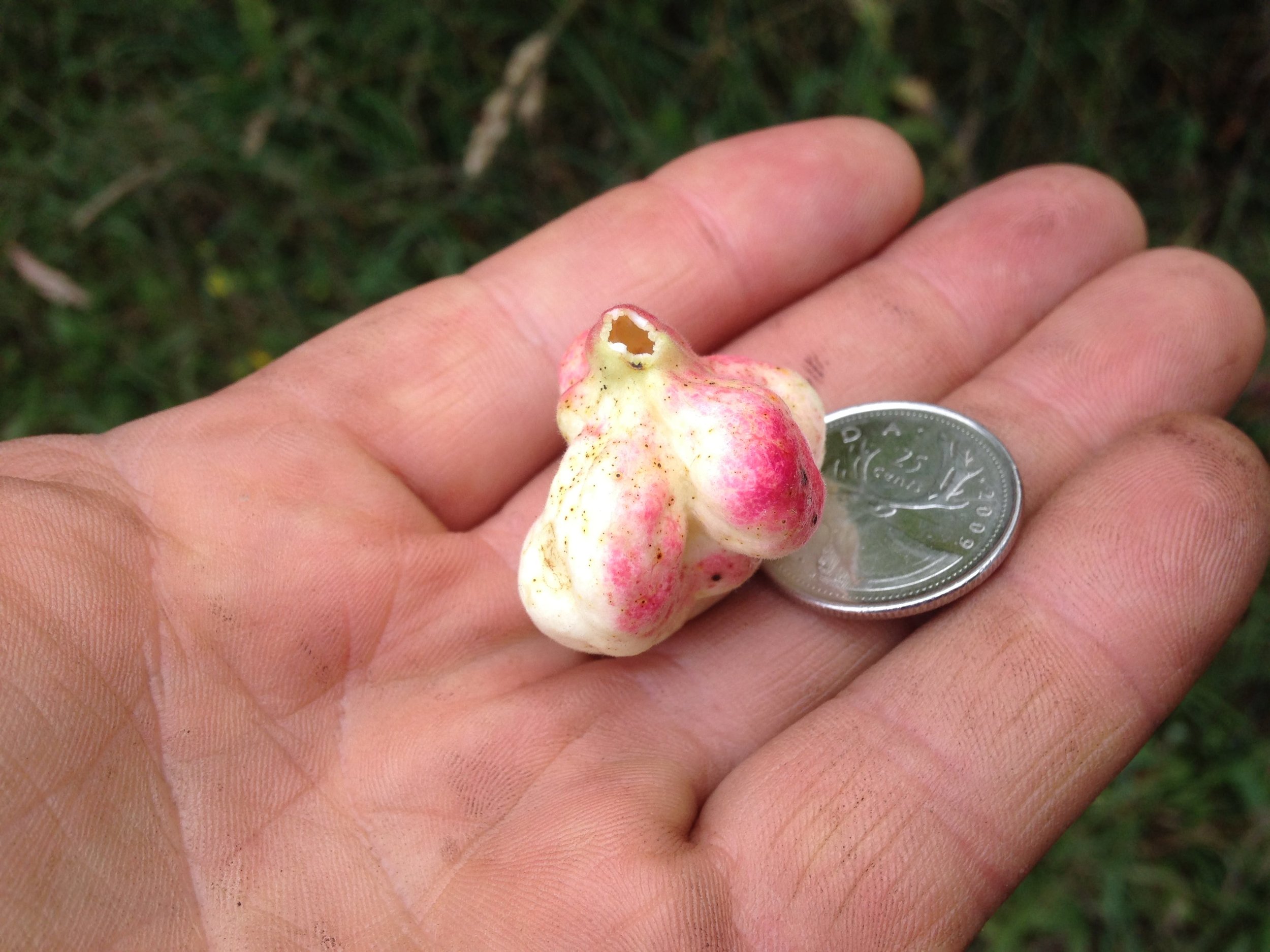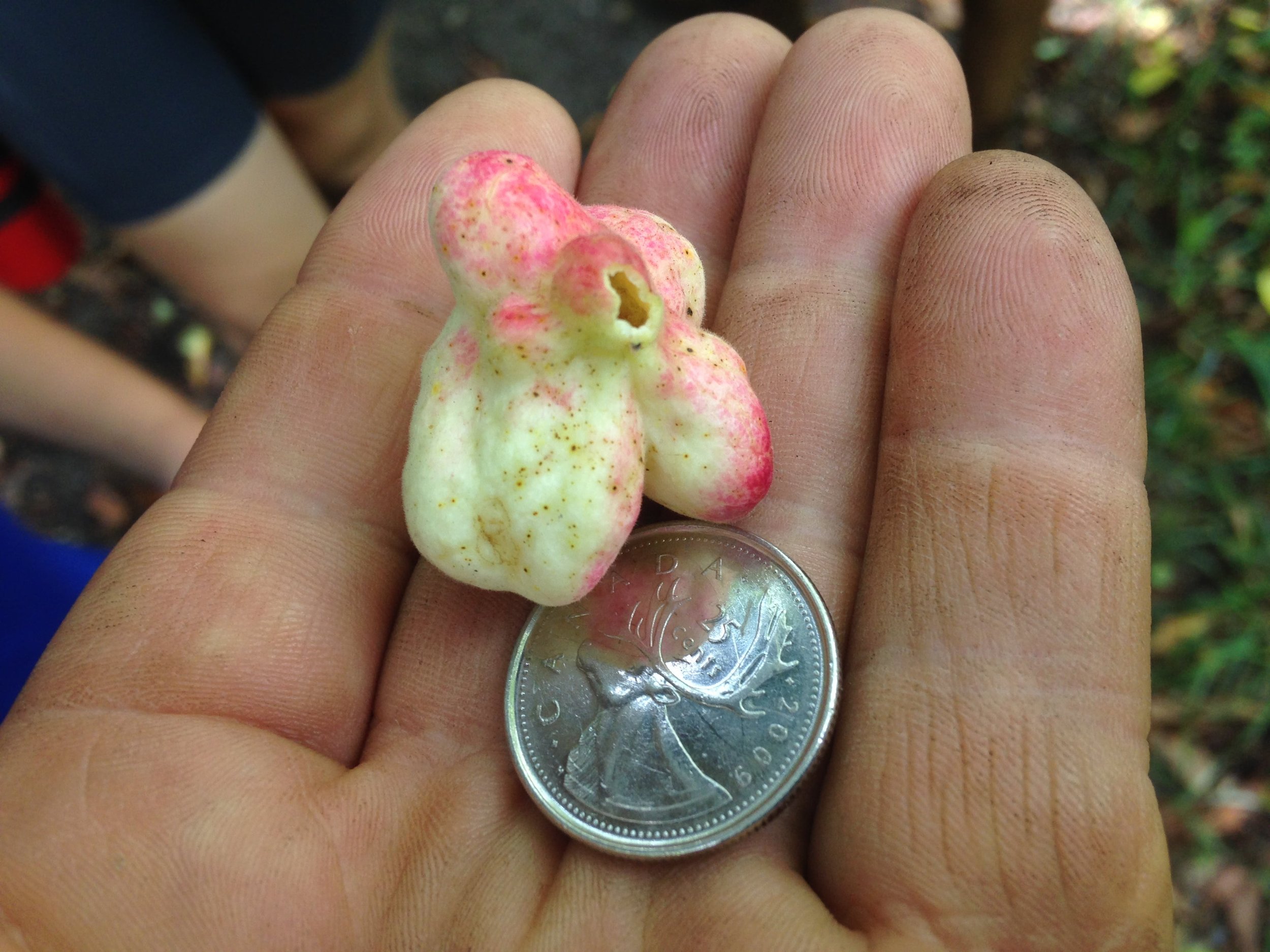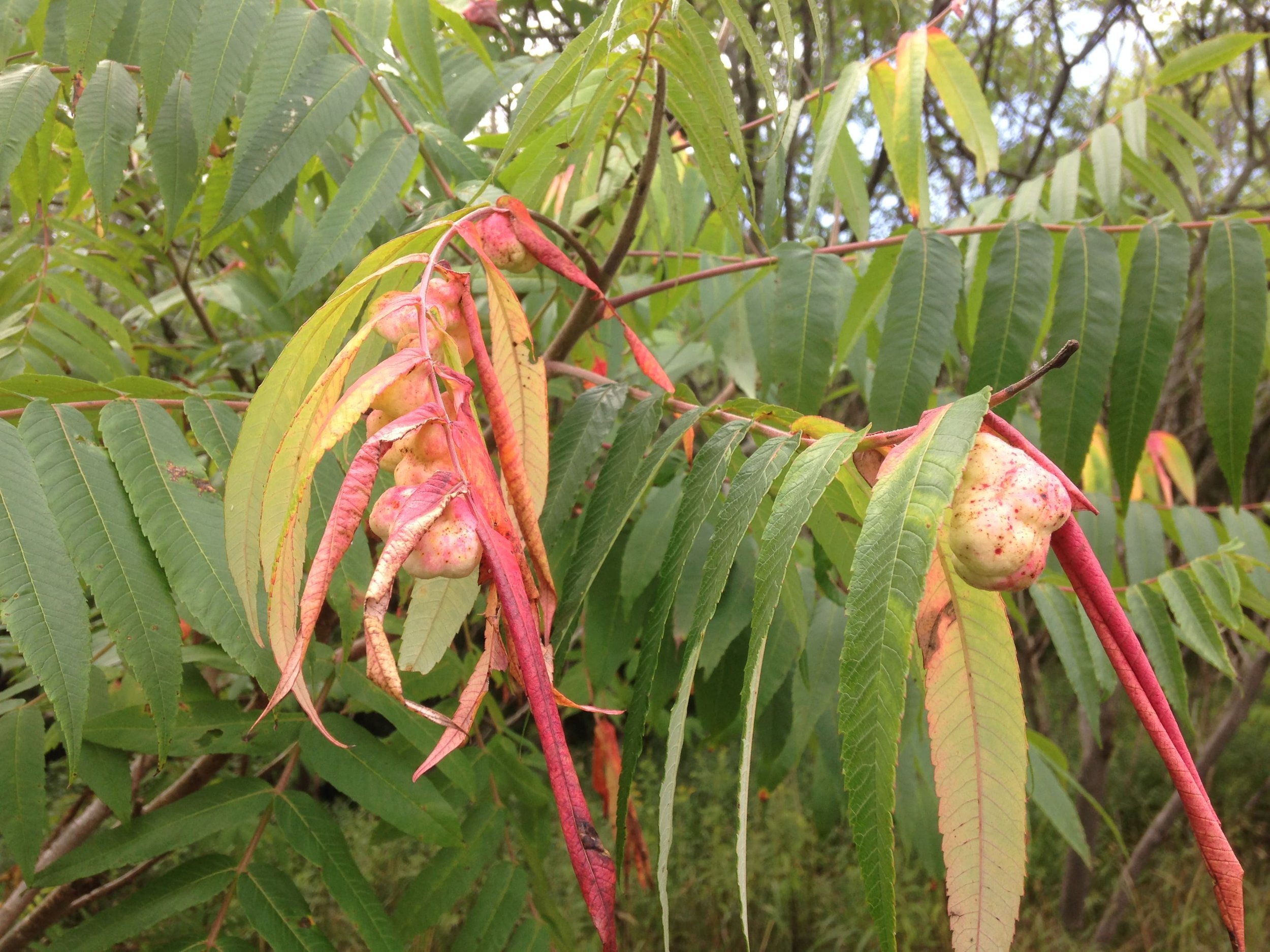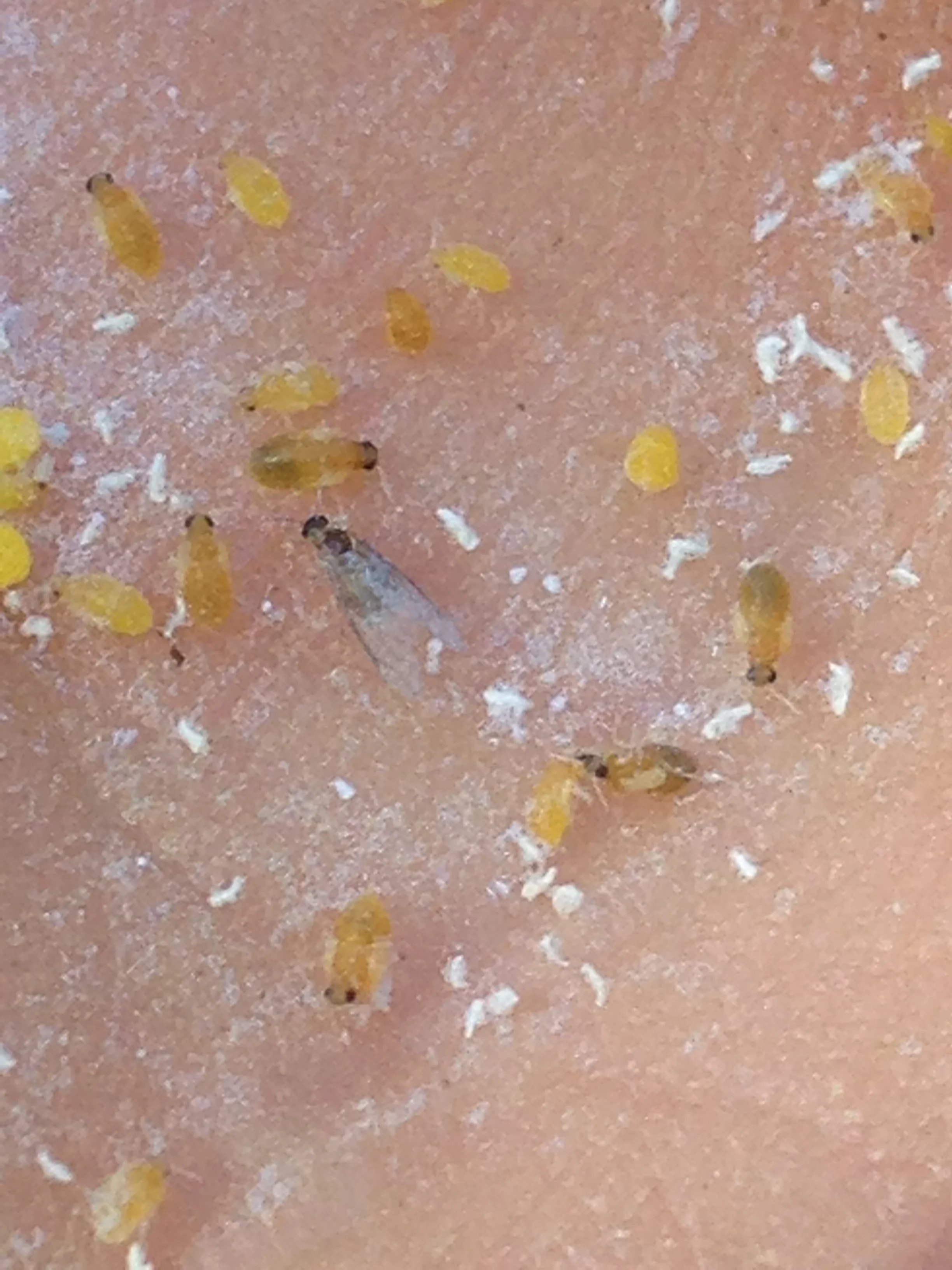Exploring Some Staghorn Sumac Galls
A few years ago my partner and I were leading a walk at a nearby nature reserve when one of the participants looked up at a Staghorn Sumac (Rhus typhina) and asked “what is this?”. I answered, Staghorn Sumac, but they clarified that they didn’t mean the shrub, but instead globular fleshy piece which sort of half dangled from the bottom of the long leaf stalk. As we looked at the soft roundish growth I realized that I had never noticed this before. I didn’t even have the notion of where to look to find out more information about what I was looking at. I assumed it was a gall and explained what a galls were: abnormal growths or swelling induced by the interaction of an aggravating life form with the plant. Those life forms could be an insect, a mite, a fungi, bacterium, nematode, or even a virus. The plant releases growth hormones and chemicals to quickly form thick tissue growth around the animal, fungi, or bacteria which is interacting with the plant. While galls can sometimes be harmful for the plant host, they aren’t always. Some are benign, some may even be beneficial. This seemed good enough to assuage the curiosity of all those present, though I was still intrigued. I took a couple of photos and kept on with the walk. I didn’t forget the gall from the Sumac leaves though, and more recently in my new found interest in galls I began looking for them along the trails I walk everyday at work.
A more recent photo of the galls on the Staghorn Sumac (Rhus typhina) leaves. Taken 2022.08.26.
It happened that one late August day I was out with some kids on a longer hike when we walked through a gauntlet of tall Sumac shrubs. Many arched over the path creating a tall tunnel for us to walk through. We noticed the leaves were beginning to turn to their vibrant red and pale yellows and I was high-fiving all the leaves at my eye line which we passed when I suddenly stopped, and backpedaled a couple feet realizing that I had just seen those same galls from many years ago. I announced a quick break from our hike and for them to get out their water for a drink. This bought me a couple of minutes to superficially investigate.


When I broke off a gall from the leaf stalk the first thing I noticed was how light it was. It felt no heavier than a couple of Sumac leaflets in my palm. I also noticed a hollowness to the broken area where the gall had been attached. This hole into the gall was too small for me to try and peer into considering the amount of light I had to work with, and though I didn’t want to disturb the structure of the gall, I ended up tearing into it to examine the inside of the structure.
I noted the flesh felt thin but strong, but I couldn’t name now anything to compare it with. When I pulled the gall apart, I noted first the fluffy white stuff started floating around blowing in the slight breeze through the Sumac tunnel. I saw small orange things which reminded me of a small seed or insect egg. I wasn’t certain what it was but alas I was with the kids and they were getting restless and we had to move on. Having dumped the white stuff and little orange things from my hand and tossing the remains of the gall to the side I continued on with our walk, but made a note of where the galls were so I could return to investigate a little further.
The next week, I was out with another group of kids. This group was very disinterested in anything I could offer and just wanted to spend time socializing amongst themselves. Having realized this I decided it would be a perfect opportunity to hike to the galls with the kids. I could take more photos and the kids could play, sing, and just hang out, which is all they wanted. When we got to the galls I tried to enchant them with the magic of invertebrate-shrub relationships, but they weren’t having it. So I gave them some boundaries, a timeline and asked them to return when I called. They said yes, walked 15 feet away and sat down. They didn’t feel like hiking anymore.
I noticed a couple of leafstalks laden with galls. It seemed like there could be one to 6 or 7 galls per leaf stalk and if I remember correctly they were mostly at the distal end though some were located in the middle between the trunk and the tip of the leaf stalk. I pulled two more galls off and sat down to inspect them. This time I tore one open right away and knocked out the contents onto a purple notebook to offer contrast for my photos. I even pulled out my field lens so I could take photos through the lens and try to see more detail on the little orange egg shaped things.
What I noticed this time, having the chance to sit still with the gall and the contents in my hand was that the small orange egg shaped things were moving on their own. There was a breeze blowing the white fluffy things around but the small creatures were definitely moving in ways and directions that wouldn’t have been caused by the wind. Turns out these tiny things were the insects which created the galls!
These are the Sumac Gall Aphids (Melaphis rhois) which are a species of Woolly Aphid in the same Aphid subfamily (Eriosomatinae) as the Woolly Ash Aphid I wrote about last year. The Sumac Gall Aphids were so weird and cute with their oviform orange bodies with big black eyes that I got really excited and decided to try and observe them as best I could… but my findings just showed them flopping around on themselves. Were these the young, newly incarnated and therefore had little control over their limbs? Is that a thing for insects?
So just to recap on our little Woolly Aphid friends, their sexual habits are incredible! So say it’s early Spring and a little M. rhois lady Aphid wakes up from in her mossy bed, to fly up to the leaf of a nearby Staghorn Sumac and along the midvein of a leaflet she deposits an egg. The egg triggers the growth of a gall over the next few days. Galls grow and as they do the aphid inside reproduces parthenogenically, cloning herself and creating genetic copies of herself. Some Aphids can give birth to 5 or 6 clones a day! These clones are born pregnant ready to give birth to more clones in a couple of days. Amazing.
This parthenogenic reproduction happens for a couple of generations until the fall, when the female M. rhois’ then migrate to some nearby mosses where they feed and spend the winter in colonies asexually reproducing their clones. At some point, which I have not come to know yet, males are generated and they mate with the females in the early Spring. Following the mating winged females fly back up to the Sumac leaflets where she then deposits eggs and the whole thing begins again.
I have read that another host aside from the Staghorn Sumac is the Smooth Sumac (Rhus glabra) which can also be found in an around Guelph (there are two sightings on inaturalist by in the ditch on the SW side of Watson pkwy S. by the dump a.k.a the “Waste Resource Innovation Centre”). The Staghorn Sumac and the Smooth Sumac have been in a LTR with the Sumac Aphids for about 48 million years, likely going through these same routines year after year. When I look at the gall formations now, it appears that they do not seem to harm the Sumac plants at all. It is as if over time the Aphids and the Sumacs have come to a pleasant relationship… perhaps something to work towards in my own life (in a much shorter time span, of course).
Next Spring, I will be on the watch for these Aphids and for the the beginnings of their galls. It would be really cool to see an Aphid depositing her eggs and to get a couple photos of that happening. Until then, I’ll just have to keep learning about them from the books and online.
To learn more :
Sumac Gall Aphid : More than meets the eye
A 48-Million-Year-Old Aphid--Host Plant Association and Complex Life Cycle: Biogeographic Evidence



